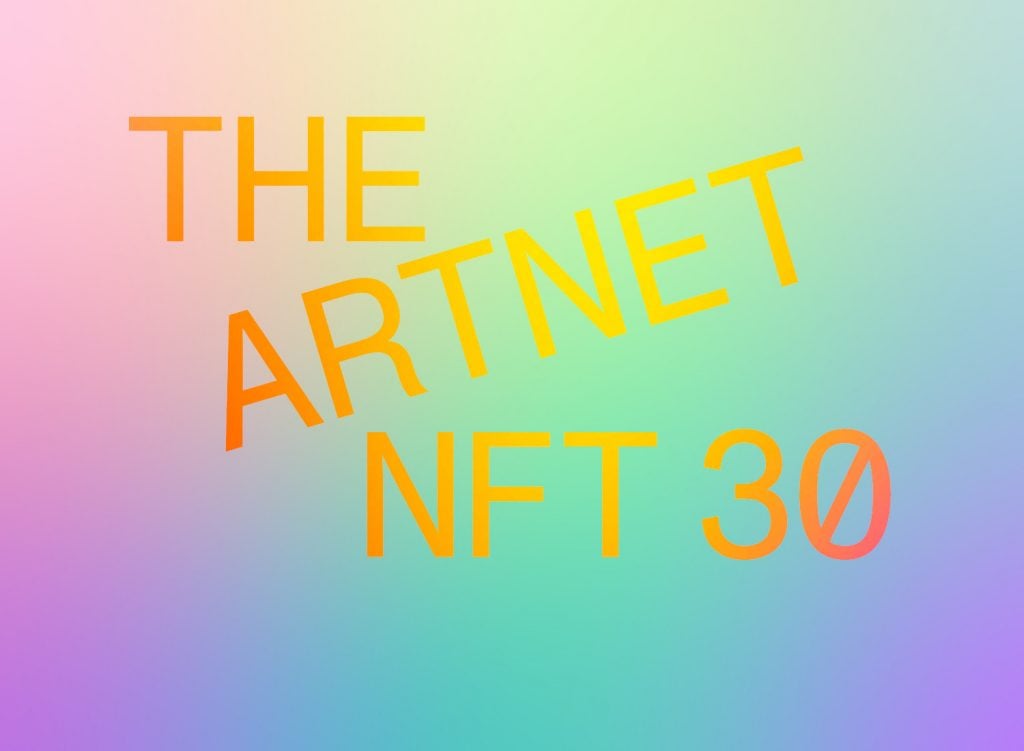16/12/2021 Introducing: The Artnet NFT 30 Report
Who are the figures powering today's NFT boom? The Artnet NFT 30, sponsored by the APENFT Foundation, offers an introduction to key players.
 The Artnet NFT 30 report is here.
The Artnet NFT 30 report is here.Who are the figures powering today’s NFT boom? The Artnet NFT 30, sponsored by the APENFT Foundation, offers an introduction to key players.
Since its emergence in 2019, the coronavirus pandemic has utterly upended the world, bringing unimaginable loss, locking down large swaths of human society, and also unlocking long-suppressed opportunities that once seemed unimaginable. We developed new ways to communicate and saw brick-and-mortar businesses build a digital infrastructure essentially overnight. But perhaps the biggest transformation for the art industry arrived this year, with the explosion— and, yes, it has rocked the establishment like a bomb—of NFTs onto the scene.
If c’s drip paintings “broke the ice” for Abstract Expressionism, as Willem de Kooning said, Beeple’s historic March auction shattered it into smithereens for NFTs. The $69.3 million result forEverydays: The First 5000 Dayswoke up the world to the electrifying combination of groundbreaking art, new tech, a ballooning market, and a massive, global, young, and previously uninterested collector base. Everyone—from disaffected art lovers to corporations of all stripes—started paying attention.
But, of course, there’s more to the story, because NFTs as we know them today are just the first flower of a movement that has been germinating for quite some time. And it is absolutely vital for anyone interested in engaging with the NFT phenomenon to understand that history—because it’s the only way to see through the fog of volatility, astounding numbers, whipsawing cryptocurrency valuations, technical jargon, and ostensible silliness of much of the current moment and glimpse the radical future ahead.
It’s in this spirit that Artnet NFT, a new initiative devoted to supporting (and accelerating) the emergent category of crypto art, has put together the Artnet NFT 30. It is a way to shed light on a history that may be less familiar to the mainstream art world through the people—famous, anonymous, visionary, and collective—who have built this new paradigm brick by digital brick.
This is by no means a comprehensive list, or a scientific one. It also is not the list the art establishment might want you to see, since it leans more toward the disruptors than those who have tried to harness the disruption to their own ends. Rather, it is Artnet NFT’s curated view of some of the players we think should get their due as crypto art’s gutsiest innovators—the true OGs. We hope you enjoy it.
– Andrew Goldstein, Editor-in-Chief of Artnet News
ABOUT ARTNET NFT
“The world, in some sense, belongs to coders,” says Gavin Wood, the cofounder of Ethereum and creator of Polkadot.
We are experiencing a revolution similar to that of the 1990s, when the internet transformed the world. Now, the future of the internet at large depends on how we build robust protocols for value exchange on top of blockchain technology. NFTs—or non-fungible tokens—have opened up a new world for digital natives to create, transact in, and build a sustainable ecosystem of art and creativity. At Artnet, we are ready to be part of this exciting moment and help push the boundaries of art and technology.
Artnet was born in 1989 alongside the internet itself. Since then, we have been transforming the art market through technology for over 30 years. Our quest to bring transparency and efficiency to the art world made it possible to access the inventory of thousands of international galleries, bid in the first online auctions for art, search for auction prices worldwide, and read about the art world online in real time. Today, Artnet is host to over 50 million visitors per year from every part of the globe and every walk of life. We’ve democratized the art market, with the help of the internet.
The NFT initiative at Artnet marks a new milestone in our history. We now offer NFT content and works for sale across all of our products and channels. As the premier destination for all people who love art, Artnet is committed to being a place of discovery in the ever-expanding conversation around art and technology.
– Jiayin Chen, director of Artnet NFT
ABOUT THE SPONSOR
Officially registered in Singapore on March 29, 2021, APENFT Foundation is backed by the underlying technology of the Ethereum and TRON blockchains with support from BitTorrent file system, the world’s largest distributed storage solution. Its mission is to provide a dynamic platform for the creator economy while creating a financial bridge between the metaverse and the real world. APENFT Foundation’s extraordinary collection of art from the modern era to today includes masterworks by Picasso, Andy Warhol, and Alberto Giacometti alongside key examples from Beeple, Pak, FEWOCiOUS, Mitchell F. Chan, and other emerging crypto artists—all of which is made available for the entire community through a series of curated online virtual exhibitions.
APENFT Foundation’s curatorial strategy is led by its director, Sydney Xiong, an art-world veteran with a specialization in postwar and contemporary art. The APENFT Foundation is a partner to renowned art institutions such as Sotheby’s and Christie’s, for whom it sponsored the fourth annual Christie’s Art + Tech Summit: NFTs and Beyond in New York, receiving media coverage from such outlets as Artnet News,ArtReview,Artnews, CoinDesk, and Cointelegraph. As the leading tech-driven art foundation, APENFT Foundation aims to catalyze its high-quality audience to support the development of the decentralized metaverse’s ecosystem.
 (0)
(0)
 (0)
(0)
https://news.artnet.com/market/introducing-the-artnet-nft-30-report-2047609
